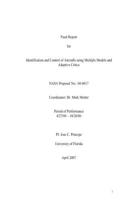
Identification and Control of Aircrafts Using Multiple Models and Adaptive Critics
Series:
We compared two possible implementations of local linear models for control: one approach is based on a self-organizing map (SOM) to cluster the dynamics followed by a set of linear models operating at each cluster. Therefore the gating function is hard (a single local model will represent the regional dynamics). This simplifies the controller design since there is a one to one mapping between con
NaN
VOLUME
English
Paperback

We compared two possible implementations of local linear models for control: one approach is based on a self-organizing map (SOM) to cluster the dynamics followed by a set of linear models operating at each cluster. Therefore the gating function is hard (a single local model will represent the regional dynamics). This simplifies the controller design since there is a one to one mapping between controllers and local models. The second approach uses a soft gate using a probabilistic framework based on a Gaussian Mixture Model (also called a dynamic mixture of experts). In this approach several models may be active at a given time, we can expect a smaller number of models, but the controller design is more involved, with potentially better noise rejection characteristics. Our experiments showed that the SOM provides overall best performance in high SNRs, but the performance degrades faster than with the GMM for the same noise conditions. The SOM approach required about an order of magnitude more models than the GMM, so in terms of implementation cost, the GMM is preferable. The design of the SOM is straight forward, while the design of the GMM controllers, although still reasonable, is more involved and needs more care in the selection of the parameters. Either one of these locally linear approaches outperform global nonlinear controllers based on neural networks, such as the time delay neural network (TDNN). Therefore, in essence the local model approach warrants practical implementations. In order to call the attention of the control community for this design methodology we extended successfully the multiple model approach to PID controllers (still today the most widely used control scheme in the industry), and wrote a paper on this subject. The echo state network (ESN) is a recurrent neural network with the special characteristics that only the output parameters are trained. The recurrent connections are preset according to the problem domain and are fixed. In a nut
Price Comparison [India]
In This Series
Bestseller Manga
Trending NEWS




















